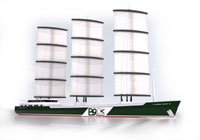
Proposed B9 3000dwt sailing cargo ship
I love the headline in the article in Sail-World – Britain set to introduce sailing ships to counter emissions. The first paragraph reads:
It’s official. The days of sail may be just about to recommence. The UK’s Committee on Climate Change has come out with a report that recommends ‘installing supplementary power systems to make use of solar or wind power’ on British ships.
Wouldn’t it be interesting, if it were true. It isn’t.
The report they reference, Review of UK Shipping Emissions, Committee on Climate Change, November, 2011, is a jumble of recommendations, the first of which is that international shipping emissions should be included now in the 2050 target for emissions permitted under the Climate Change Act. What follows is an extended bureaucratic discussion of how that may be done.
What gets interesting and slightly comical is when the report actually makes recommendations as to how ships can be made more efficient and less polluting. The report doesn’t at any point mandate or even recommend a return to sail, except on the periphery. Specifically they recommend:
Technological
- Upgrades to propulsion systems and changes to engines, such as tuning to a lower power output or electric drives. Towing kites can also be employed to allow ships to use energy from the wind, weather conditions and route permitting.
- Application of hull coatings to reduce friction and fuel consumption, or increases in the frequency of hull cleaning.
- Changes to auxiliary power systems, such as improving energy efficiency, using solar or wind power and improving boiler technology.
- Optimisation of the hull, including the addition of bulbous bows. Although still unproven air lubrication of the hull for new vessels, where the ship floats on a carpet of bubbles, may reduce frictional resistance.
Operational
- Reducing speed which, because power requirements increase as the cube of speed, saves fuel even if the journey takes longer.
- Software that combines logistical planning with weather data to ensure that the ship sails the safest and most efficient route given the weather it is likely to encounter.
- Routine monitoring using software packages to optimise ballast and trim.
- Improvements to port turn-around times and access to real time port congestion information can reduce emissions by allowing ships to sail slower rather than proceeding by allowing ships to sail slower rather than proceeding at normal speed and waiting at anchor until a berth becomes available.
They also recommend switching to bio-fuel and LNG, while acknowledging that there remain a number of technical issues to be resolved before LNG is practical as a fuel. Aside from recommending the use of kites and unspecified auxiliary “wind power,” there is no real significant endorsement of sail for propulsion
There is nothing wrong with theses recommendations except that most have already been implemented. These are not new ideas. Improved engine efficiency is something that has been worked on for many years. The work to develop better coatings dates back to the 18th century. Likewise improved hull design using bulbous bows dates back a half century or so. Slow steaming and weather routing are already common practice, as are efforts to reduce port congestion.
The comical aspect is the prediction that these recommendations could reduce shipboard emissions by 70%. This is followed immediately by the acknowledgement that:
- Some abatement measures may not represent actual emissions savings because they are already standard in ships.
- Some measures, such as air lubrication, depend upon the technology being made to work in real sea conditions.
So basically, never-mind.
Fortunately, there are those working toward the return of commercial sail. B9 Shipping and FairTransport are two good examples and we can only wish them well.
Thanks to Irwin Bryan for passing the article along.
